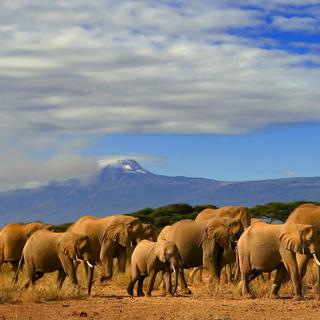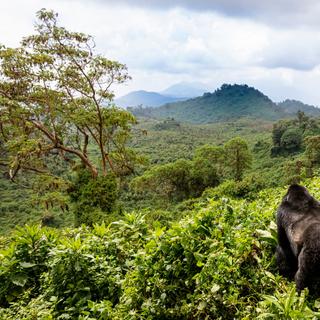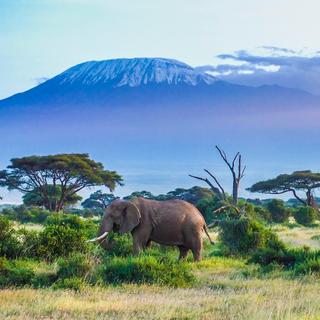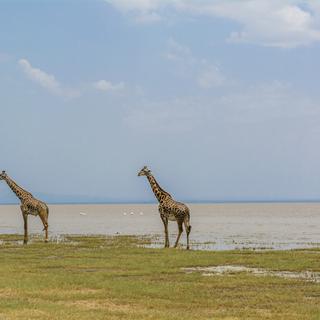
Serengeti weather and climate in 2025

Serengeti weather and climate in 2025
Day
27 °C
Night
14 °C
Precipitation
36 mm
in month
Rainy days
7 days
in month
Daylight
12 hours
average
Sunshine
7 hours
average
Humidity
66 %
Weather charts for Serengeti
Destinations nearby and activities
Destinations nearby
Activities in Serengeti

Find more destinations like this
Destinations with similar weather to Serengeti
Other destinations in Tanzania - National parks
Closest cities for Serengeti
Last week's weather in Serengeti
Average daily temperature during the week of 30 June 2025 - 6 July 2025 was 29 °C (84 °F), average minimal (night) temperature was 17 °C (63 °F). These temperatures are slightly above the long-time average for Serengeti, being 26 °C (79 °F) for daily temperatures and 15 °C (59 °F) for night temperatures. The average temperatures observed during different times of day (based on local time) were as below: 7am 17 °C (63 °F), 10am 22 °C (72 °F), 1pm 28 °C (82 °F), 4pm 27 °C (81 °F), 7pm 21 °C (70 °F), 10pm 20 °C (68 °F).
During this week: 1 day without rain, 3 days with light rain and 3 days with moderate rain were observed. The total precipitation for the week in Serengeti was 19 mm (0.75 in), which is above the area's average of 7 mm (0.28 in). From dawn to dusk, there was an average of 79 % cloud coverage during the day.
An average wind speed of 1.7 m/s was recorded. Prevailing wind direction(s) were East and North-East. The air pressure varied between 1010 hpa and 1019 hpa. On average, the air humidity in Serengeti was 61 %.
During the daytime (from dawn to dusk), there were in average: 1 hour clear skies, 2 hours partially overcast skies, 8 hours overcast skies and 2 hours rainy weather. On average, the time of sunrise was 06:44, and the time of sunset was 18:45.
Weather overview for Serengeti
Weather overview
The Serengeti region of Tanzania is known for its tropical climate, which provides an array of temperatures and weather conditions throughout the year. Daytime temperatures fluctuate between an average low of 26 °C (79 °F) in the cooler month of July to a high of 29 °C (84 °F) during the warmest month of February. As you might expect, rain patterns are just as varied, with July being remarkably dry, having approximately 5 days with rainfall, compared to April, the peak of the rainy season, with around 18 days experiencing rain. Night temperatures also vary, dropping to an average low of 14 °C (57 °F) in July and reaching their highest at 16 °C (62 °F) during the month of April.
January weather
As March approaches, we see the day temperature in the Serengeti start to increase, settling at 28 °C (83 °F). The frequency of rainy days continues to decline from the previous month, totaling 10 days. A decrease in accumulated rainfall begins to become apparent, showing 88 mm (3.46 in). Simultaneously, there's a gradual increase in the number of clear, sunny hours, reaching 8 hours.
February weather
The peak of daytime temperatures is apparent in the Serengeti, registering 29 °C (84 °F). A downward trend in rainfall is noted, as is a reduction in the number of rainy days to 10 days. As we journey further into the year, the amount of pure sunshine peaks at 8 hours.
March weather
The commencement of an increase in the number of rainy days is detectable in Serengeti, with the count being 14 days. Concurrently, the rainfall volume begins to swell. A downward shift in hours of uninterrupted sunshine is noted, with a decline to 8 hours.
April weather
As April unfolds, a decrease in the daily temperatures becomes apparent in the Serengeti, averaging 27 °C (81 °F), while the culmination of the nocturnal warmth is reached in this month. With the onset of the wet season, the number of rainy days spikes to an all-time high for the year at 18 days, and the volume of rainfall likewise hits a peak, registering 149 mm (5.88 in). The least number of clear sky hours is also a noteworthy trend.
May weather
The downward trajectory of the daytime temperature persists in the Serengeti, with a reading of 26 °C (79 °F). The commencement of a decline in rainy days is discernible, at 15 days, alongside a commencing drop in the volume of rainfall, now at 91 mm (3.58 in). The apex of atmospheric humidity is witnessed within this time frame. Nevertheless, it remains within the boundaries of the wet season.
June weather
As the Serengeti enters June, tourism starts to invigorate. A persistent decline in rainy days is observed, numbering 9 days, and the rainfall continues to lessen, with a tally of 42 mm (1.64 in). A commencement in the decrease of nighttime temperatures is also notable, now at 15 °C (59 °F). The nadir of daytime duration can be seen, while a nascent increase in hours of clear skies makes itself apparent.
July weather
The tourist season is in full swing within the Serengeti. The scant number of rainy days is realized, with an average of 5 days, and even the total rainfall is at its most minimal, summed up at 19 mm (0.75 in). A low point in daytime temperatures is observed, sitting at 26 °C (79 °F), while night temperatures also bottom out, averaging 14 °C (57 °F). The highest wind speeds are witnessed during this month.
August weather
August in the Serengeti signifies a turning point where daytime temperatures begin to climb, reaching an average of 27 °C (81 °F). The season of tourists continues to bloom, and concurrently, the dry spell persists. The upswing in the number of rainy days can be glimpsed, now calculated at 7 days, along with a gradual increase in rain volume.
September weather
The Serengeti witnesses a continual uprising in day temperatures, reaching an average of 28 °C (82 °F), whilst the nocturnal temperatures also make a subtle ascent. Tourist activity remains strong. The incremental rise in the number of rainy days is discernible, recorded at 9 days, with the corresponding uptick in rainfall also evident. The progression of sunny hours also accelerates.
October weather
The ongoing flow of tourists in October enjoys the increasing warmth of the Serengeti, with the mercury rising to an average of 29 °C (83 °F). The number of rainy days maintains its ascent, notching up to 11 days, and the climb in the amount of rain continues apace, now measured at 60 mm (2.37 in). The lowest levels of humidity for the year are also reflected.
November weather
November's weather pattern in the Serengeti reveals a similar increase in rainy days as the previous month, counted at 16 days, and precipitation routinely intensifies, reaching 98 mm (3.85 in). The initial downturn in sunny hours becomes evident. The intrinsic start of the cooling down of the daily temperature can also be perceived.
December weather
In December, the incipient descent in the number of rainy days is visible, as is the maximum stretch of time the sun spends above the horizon each day in the Serengeti.
FAQs
What changes are observed in the average daily temperature in Serengeti during March?
In March, the Serengeti sees an upturn in its average day temperature, reaching 28 °C (83 °F).
What is the trend in rainfall during the peak of daytime temperatures in Serengeti?
As daylight temperatures hit their peak, Serengeti experiences a decrease in rainfall, with an average of 10 days recording rain.
Does the increase in rainy days during the Serengeti's March coincide with any other weather trends?
Certainly, March in the Serengeti not only brings more rainy days, tallying 14 days, but also a decrease in clear sunny hours to 8 hours.
What happens to the temperature during the evening in Serengeti's April?
The night temperature in April reaches its highest yearly level in the Serengeti, averaging 16 °C (62 °F).
How does the ongoing wet season in May affect rainfall in Serengeti?
The persistent wet season in May sees a slight reduction in rainfall, with precipitation totaling 91 mm (3.58 in) across 15 days.
What makes June a particularly inviting month for visitors to Serengeti?
The inviting climate of June in the Serengeti, marked by reduced rainfall and a comfortable day temperature averaging 26 °C (79 °F), makes it an ideal time for visitors.
What is the likelihood of encountering rainy days in Serengeti in July?
July in the Serengeti typically presents the least chance of rain, averaging merely 5 days of rainfall for the whole month.
Is the dry spell in Serengeti during August noticeable in terms of rainfall amounts?
Indeed, even with the dry period in effect, an upward tick in rainfall amount is seen, but rainy days remain relatively uncommon, numbering 7 days.
In September, what is the trend in the number of sunny hours in the Serengeti?
As the Serengeti moves through September, the average number of clear sunny hours tends to increase, promising more sunlit time for outdoor activities.
How does the humidity in October affect the overall feel of the weather in Serengeti?
Despite the rising temperatures, October in the Serengeti feels quite comfortable thanks to the relatively low humidity levels, averaging 61 %.
Is the amount of rain in Serengeti substantial during the month of November?
November in Serengeti brings a significant uptick in rainfall, with expected rain amounts measuring around 98 mm (3.85 in).
As December ends, what weather shifts might a visitor observe in Serengeti?
By the close of December, visitors to the Serengeti will notice a reduction in rainy days and the longest daylight hours of the year.








